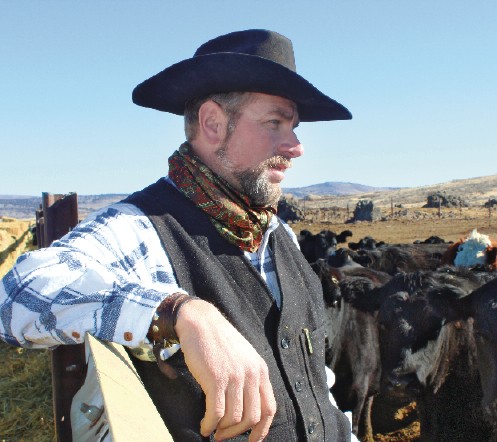Klamath Basin farmers, ranchers face
tough water year
Issue Date:
February 5,
2014 by Christine Souza,
Ag Alert, California Farm Bureau
Federation

Modoc
County cattle rancher Lucky Ackley
is concerned about the lack of water
supply in the Klamath Basin, but
said he does not want to reduce the
size of his herd.
Photo/Kathy Coatney

Balancing the varied irrigation needs of
the Klamath Basin can be difficult in a
normal water year with a good-sized
snowpack, and the balancing act becomes
even more challenging during a
multi-year drought, as water officials,
farmers and ranchers, and others work to
find solutions to carry all water users
through the season.
Modoc County
cattle rancher Lucky Ackley, whose
irrigation water comes from Upper
Klamath Lake through the Klamath
Reclamation Project, said he is not
optimistic about the coming season and
is worried about lost income.
"I have all the water year forecast
graphs for the Klamath Basin to show
where we are compared to where
historically we should be. If things
don't change drastically, this could be
one for the record books," said Ackley,
who raises cattle and farms 2,000 acres
of alfalfa and seed grain in the Klamath
Basin. "The toll of this will be
unsurpassed. I know that our
counterparts down south find themselves
in the same boat. This state will once
again remember how important agriculture
still is to its economy. I just hope it
survives this hard learning curve."
Greg Addington, executive director of
the Klamath Water Users Association,
said its best estimate is that the
supply for the Klamath Project will be
significantly less than 50 percent of
average and perhaps as low as 25
percent.
"The flip side is that we can heal
fast if Mother Nature cooperates," he
added. "We still have time to improve
the situation with more snow and rain."
Precipitation in the Upper Klamath
Basin and inflows to project reservoirs
have been well below average for the
2014 water year to date, reported Don
Bader, acting area manager for the U.S.
Bureau of Reclamation Klamath Project,
who added that the snowpack was only 23
percent of median as of last week.
"The water supply available to the
Klamath Project during 2014 will depend
on the amount of precipitation between
now and April 1, when Reclamation will
determine and announce the 2014 water
supply," Bader said.
Rancher Ackley said project customers
typically consider a full supply to be
between 360,000 and 400,000 acre-feet,
which can come from surface water or a
combination of surface and groundwater.
"We are somewhere around 200,000
acre-feet short right now," Ackley said.
"I can cover my farm ground with my
wells with or without assistance, but
when I turn the wells on and irrigate my
own ground, that increases my cost about
$360 to $380 an acre. This year it will
be worse, because there is zero moisture
in the ground, so we will have to pump
more just to make up for what we don't
already have."
As for his cattle, Ackley said, a
lack of spring rains needed to encourage
the grass to grow would mean he'd be
pasturing the cattle on his own hay
fields—fields that he would rather use
as income.
"If I don't get assistance from the
Bureau of Reclamation (via a Water Usage
Mitigation Program) to pump water onto
my own fields, then I'm going to do it
myself and take the full brunt of the
cost. And if the range doesn't produce
what it should, my cows will be back on
my private land, and that will take away
income from hay that I should be
getting," Ackley said. "I'm not selling
my cow herd. I'll feed up every flick of
hay I bale before I sell the cow herd."
Meant to benefit protected fish and
provide irrigators with water supply
certainty earlier in the season, a joint
biological opinion from the U.S. Fish
and Wildlife Service and National Marine
Fisheries Service allows for daily
calculations for flows and lake
elevations that mimic actual hydrologic
conditions. The opinion began last year
and remains in effect through 2023.
"What is good about it is that we
will know in April what we have to work
with," Addington said. "Even though we
expect that number to not be great, at
least we will have a number, something
we haven't had before."
Klamath Basin irrigators were denied
water in 2001 so agencies could benefit
fish protected under the Endangered
Species Act. To prevent a future
shutoff, irrigators negotiated the
Klamath Basin Restoration Agreement,
which aims to establish sustainable
water supplies and power rates for
irrigators, restore fish habitat and
help the Klamath tribes. The agreement
also includes the Klamath Hydroelectric
Settlement, which calls for removing all
or part of four hydroelectric dams on
the Klamath River. Addington said he
expects legislation to implement the
agreements will be introduced this
spring.
Rancher Scott Murphy of Etna,
president of the Siskiyou Resource
Conservation District, expressed concern
about impacts to farmers along the Scott
and Shasta rivers once the dams are
removed.
"We don't have an elaborate
irrigation system, yet if those dams do
come out, there's a good possibility
that agencies are going to be looking at
the Shasta and Scott rivers to help
mitigate the lack of water that they are
going to have flowing down the Klamath
River," Murphy said. "If the dams do
come out, they probably need to consider
updating our irrigation systems, which
are antiquated and could stand some
improvements."
Rancher Jeff Fowle of Etna said this
year's water situation remains grim for
irrigators along the Scott and Shasta.
"In the Scott Valley, we are under 10
percent of average and the snowpack is
minimal to nonexistent. Most all of the
tributaries to the Scott River are
extremely low, and several are still not
even flowing," Fowle said. "We're in
some dire straits, barring a major or
several major events between now and
April."
Fowle explained that having to
rebuild a herd of cattle is a multi-year
investment for a rancher: "You are
looking at basically three years to
rebuild a herd again."
(Christine Souza is an assistant
editor of Ag Alert. She may be contacted
at
csouza@cfbf.com.)
Permission
for use is granted, however, credit must
be made to the California Farm Bureau
Federation when reprinting this item.

